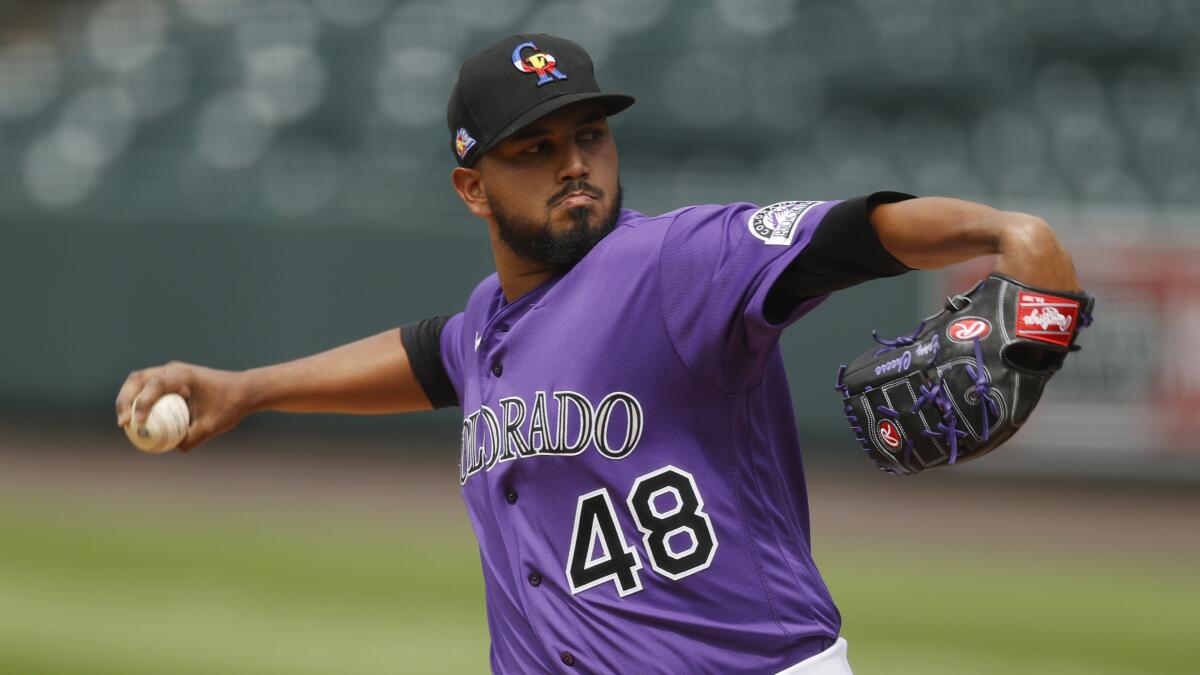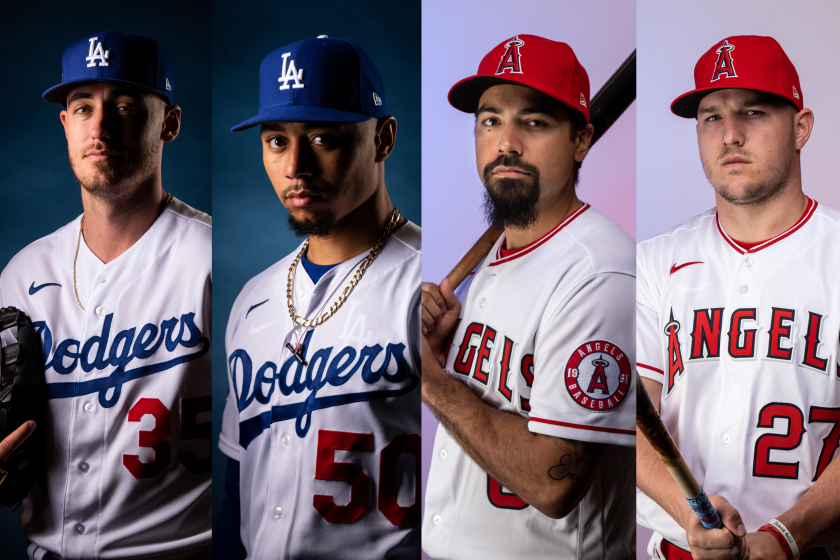Dodgers again are superior in an NL West otherwise mired in mediocrity

- Share via
SCOTTSDALE, Ariz. — This is the center of the resistance, two fortresses that rise beyond the outfield at the finest ballpark in the Cactus League.
In pre-pandemic times, the fans spread out blissfully on the lawn at Salt River Fields, with frequent trips to the free sunscreen dispensers and the $12 vodka lemonade stands. The serious business took place in a building behind left field, and another behind right field.
The Arizona Diamondbacks occupy the one in left field. The Colorado Rockies occupy the one in right. They do not share strategies, but their mission is the same, and perhaps best presented in the form of a question: Can anyone here beat the Dodgers?
The Dodgers have won the National League West for seven consecutive seasons. The last time they did not, in 2012, the rookies of the year were Bryce Harper and Mike Trout. The World Series champions were the San Francisco Giants, and four of those Giants could remain on their roster eight years later: infielders Brandon Belt, Brandon Crawford and Pablo Sandoval, and outfielder Hunter Pence. Catcher Buster Posey would have made it five had he not opted out of playing this season.

The Giants are waiting out the expiration of those contracts, and tanking. The Rockies aren’t projected to win half their games. The San Diego Padres promise to unleash their arsenal of young talent upon the division and climb toward contention, but that is a pledge they made last spring, and the spring before that, and the spring before that. Maybe this year.
Or maybe not, and the Dodgers’ primary challenger could be the Diamondbacks, and they aren’t projected by Baseball Prospectus to win more than 30 games either.
The Dodgers are heavy favorites to win their eighth consecutive National League West Division title in large part because the competition is ho-hum.
In the spring, ahead of the traditional 162-game season, Baseball Prospectus gave the Dodgers a 100% chance of making the playoffs. Now, in a 60-game “anything can happen” season, the projections give the Dodgers a 97.7% chance of making the playoffs.
“My theory is,” Rockies manager Bud Black said, “and I say this to our guys, nobody knows what’s going to happen. Nobody knows. You can run all the projections, and a lot of times they’re wrong.”
Within a reasonable margin of error, sure, but the spring projection had the Rockies finishing 26 games behind the Dodgers, over 162 games. The summer projection has the Rockies finishing 11 games back in the 60-game season, which would translate to a 30-game deficit over 162 games.
“I don’t look at them, because I’ll get mad,” Black said. “I do. I get mad. I like our team. We compete. And that’s why we’re in this, to compete.
“If the Dodgers are thought to be the Goliath, that’s fine. They can be slayed.”
The new Dodgers owners said in 2012 they’d rebuild quickly, replenish the farm system, build a sustainable winner, and invest in the right player. They are 4 for 4.
The Rockies came the closest. In 2018, the only year in the last seven the Dodgers did not win the NL West in the regulation 162 games, the Rockies forced them into a one-game tiebreaker.
Walker Buehler tranquilized them in that game, and after the Rockies beat the Chicago Cubs in the wild-card game, the Milwaukee Brewers swept them in the division series. The Rockies finished 35 games behind the Dodgers last season, and one game ahead of the last-place Padres.
The highlight of the Rockies’ winter: a cold war between Nolan Arenado, the third baseman and franchise icon, and Jeff Bridich, the general manager. Arenado signed a $260-million extension last year in the belief the Rockies would continue to win, and to invest in winning.
Their big-name winter signing: Ubaldo Jimenez, 36, who last pitched in the majors three years ago and first pitched for the Rockies 14 years ago. When the Rockies convened for summer training, Jimenez was not included.
That means the fate of the 2020 Rockies is largely in the hands of the same players who stumbled badly in 2019 — and, to be fair, won wild-card berths in 2017 and 2018.
“We’re not the ’19 team. We’re more the ’18 team,” Black said.
The Rockies scored more runs last year than they did in 2017 or 2018, but the pitching was atrocious, even by Coors Field standards.
In 2018, four starters pitched at least 170 innings. In 2019, one did: German Marquez, with an earned-run average of 4.76. Of the five other pitchers who started at least 15 games, four had an ERA above 6.00. Closer Wade Davis had an ERA of 8.65.

The Diamondbacks generally have avoided the depths to which the Rockies sank last season, but their recent record is uneven: three consecutive winning seasons, preceded by three consecutive losing seasons, preceded by two seasons at exactly .500.
This is the muddled predicament that tanking is intended to avoid. If your team is not really good, so the theory goes, then be really bad for a few years in the hope of blossoming into really good.
“We are far too competitive,” Diamondbacks president Derrick Hall said. “We are not a ‘tank it’ team.”
Under fourth-year general manager Mike Hazen, the Diamondbacks have done an admirable job of disdaining the tired “buy or sell” divide in favor of doing both. A year ago, for instance, Hazen traded franchise anchor Paul Goldschmidt.
“You could see his number retired here one day,” Hall said. “That was as tough a decision as we’ve probably ever made.”
As it turned out, the Diamondbacks put up more runs in their first year without Goldschmidt than they did in their last year with him. Christian Walker, 28, in his first everyday job in the major leagues, replaced Goldschmidt at first base and put up a higher OPS for Arizona than Goldschmidt did for his new team, the St. Louis Cardinals.
Mookie Betts and Cody Bellinger of the Dodgers, and Mike Trout and Anthony Rendon of the Angels head a sparkling cast of local mega-stars when baseball resumes.
The Diamondbacks could not see that coming when they made the trade, but they could see two new building blocks that came with the deal: Carson Kelly, who had the highest OPS of any catcher in the NL West, and pitcher Luke Weaver, who posted a 2.84 ERA last season. In surrendering a star who could have played out his last year in Arizona and left as a free agent, Hall said, fans could see the Diamondbacks were getting an immediately useful return.
“If it was straight prospects,” Hall said, “it would have sent a totally different message.”
At the July 31 trade deadline, the Diamondbacks sent pitcher Zack Greinke to the Houston Astros for three top prospects, yet they replenished their starting rotation by acquiring Zac Gallen from the Miami Marlins (this time trading away a top prospect) and Mike Leake from the Seattle Mariners. Over the winter, they signed Madison Bumgarner. Leake has opted out of the short season.
The Diamondbacks feature three veterans — outfielder Kole Calhoun and infielders Eduardo Escobar and Ketel Marte — who each hit 30 home runs last season, each for the first time in his career. They traded two prospects to the Pittsburgh Pirates for outfielder Starling Marte, who hit a career-high 23 home runs and stole 25 bases last season.
This season, at least at the start, will be played without fans. Eventually, for the Diamondbacks, getting current fans back into the park might not be as important as developing new fans.
Phoenix is the fifth-largest city in the United States, but the Diamondbacks have not ranked in the top half of the 30-team MLB in attendance since 2008.
A look at the Dodgers and the Angels as they embark on the coronavirus-shortened 2020 MLB season.
“We go to Arizona, which is in our division, and there’s more Dodger fans than Arizona fans,” Dodgers outfielder Joc Pederson told the crowd at the Dodgers’ fan festival in January. “When we don’t play the Diamondbacks, I don’t know how many people go to the game.”
“Not many,” replied teammate A.J. Pollock, who played the first seven years of his career in Arizona.
If owners and players complete a new collective bargaining agreement in 2021, the league is expected to consider realignment, perhaps in concert with expansion. Would the Diamondbacks be interested in abandoning the Dodgers and bettering their chances to win by joining a geographic grouping that could include the Rockies, Astros, Kansas City Royals and Texas Rangers?
“My initial response would be no,” Hall said. “We can compete with the Dodgers. We have. They clearly are the class of the West, and I think they have the most talented roster, by far, in our division. But there’s also been a rivalry that’s been formed.”
The Diamondbacks might not be a big draw in Los Angeles, but the Dodgers sure are in Phoenix.
“It’s important for us,” Hall said, “to have them in our division.”
More to Read
Are you a true-blue fan?
Get our Dodgers Dugout newsletter for insights, news and much more.
You may occasionally receive promotional content from the Los Angeles Times.















